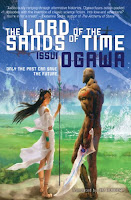 Author: Issui Ogawa
Author: Issui Ogawa
Translator: Jim Hubbert
U.S. publisher: Viz Media
ISBN: 9781421527628
Released: July 2009
Original release: 2007
The Lord of the Sands of Time was the first work by Issui Ogawa to be released in English. Originally published in Japan in 2007, Viz Media’s Japanese speculative fiction imprint Haikasoru released Jim Hubbert’s English translation in 2009. In fact, The Lord of the Sands of Time was one of Haikasoru’s debut titles along with Hiroshi Sakurazaka’s All You Need Is Kill. I find it interesting that both novels deal with alien invasion and some sort of time travel, but their approach is very different. In addition to The Lord of the Sands of Time Haikasoru has also published the only other work by Ogawa currently available in English—his Seiun Award winning The Next Continent. Haikasoru has become one of my favorite imprints so I was interested in reading The Lord of the Sands of Time not only on its own merits, but because it was one of Haikasoru’s first publications, too.
Toward the end of the 26th century, humanity is nearly wiped out by an alien invasion force and if the fighting continues they are sure to lose. But when humans develop the capability to send a group of people back in time, hope is restored. A temporal army made up of advanced cyborgs with highly sophisticated AI systems is built for this purpose. In addition to being weapons, the cyborgs, known as Messengers, are sent into the past to warn humanity of the imminent invasion. They soon discover that the alien force also has the ability to time travel. The Messengers are forced into a deadly game of leapfrog, finding it necessary to travel further and further back into human history. Winning some battles and losing others, their resources can not and will not last forever. Even the Messengers continued existence is at stake as they fight for humanity’s survival.
Although it isn’t explained in any sort of depth, time travel is extremely important in The Lord of the Sands of Time. Granted, even Orville—one of the primary characters—admits he doesn’t understand it. The only thing that matters to him (and for the sake of the story) is that it works. Unfortunately, the time travelling concepts that Ogawa does introduce don’t always seem to be as cohesive as they could be. In order to avoid confusion, I simply tried not to think too hard about the specifics and mechanics and trust what Ogawa was doing. Travel into the past, or upstreaming, is readily practiced, but once there there is no way to return; the Messengers must simply wait and hope they can survive long enough for the future to catch back up with them. The chapters in The Lord of the Sands of Time alternate between 248 AD and other time periods. The structure is interesting because 248 AD acts as the present and the future becomes the history. The narrative style also changes to emphasize this; the future is described very matter-of-factly while the present is told in a more immediate, active, and chaotic fashion.
The Lord of the Sands of Time is not a long book but the story it tells is satisfyingly complete. I really enjoyed the novel. I did find the first chapter a little difficult to get into at first, but after a slow start the pacing picks up nicely. Orville is very charismatic, both to the reader and to other characters in the novel, and I enjoyed learning more about him immensely. The other primary character, Himiko, is also interesting. She also happens to be based on a historical shaman Queen from the Yayoi period. I enjoyed how Ogawa legitimately incorporated anachronisms with events and people from history. The integration also felt natural—it wasn’t as though people were running around with laser guns in the 3rd century. Rather, their technology was more advanced within their own capabilities and resources. Since I enjoyed The Lord of the Sands of Time, I look forward to reading some of Ogawa’s other works, beginning with The Next Continent.

Speak Your Mind